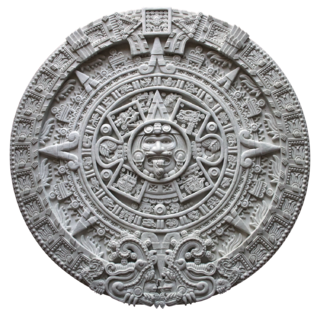
Year 378 (CCCLXXVIII) was a common year starting on Monday of the Julian calendar. At the time, it was known as the Year of the Consulship of Valens and Augustus. The denomination 378 for this year has been used since the early medieval period, when the Anno Domini calendar era became the prevalent method in Europe for naming years.
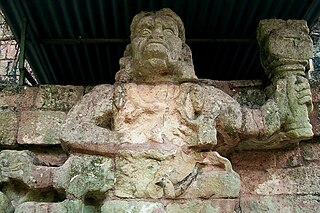
Copán is an archaeological site of the Maya civilization in the Copán Department of western Honduras, not far from the border with Guatemala. It was the capital city of a major Classic period kingdom from the 5th to 9th centuries AD. The city was in the extreme southeast of the Mesoamerican cultural region, on the frontier with the Isthmo-Colombian cultural region, and was almost surrounded by non-Maya peoples.

Uaxactun is an ancient sacred place of the Maya civilization, located in the Petén Basin region of the Maya lowlands, in the present-day department of Petén, Guatemala. The site lies some 12 miles (19 km) north of the major center of Tikal. The name is sometimes spelled as Waxaktun.

Quiriguá is an ancient Maya archaeological site in the department of Izabal in south-eastern Guatemala. It is a medium-sized site covering approximately 3 square kilometres (1.2 sq mi) along the lower Motagua River, with the ceremonial center about 1 km (0.6 mi) from the north bank. During the Maya Classic Period (AD 200–900), Quiriguá was situated at the juncture of several important trade routes. The site was occupied by 200, construction on the acropolis had begun by about 550, and an explosion of grander construction started in the 8th century. All construction had halted by about 850, except for a brief period of reoccupation in the Early Postclassic. Quiriguá shares its architectural and sculptural styles with the nearby Classic Period city of Copán, with whose history it is closely entwined.

Yax Nuun Ahiin I, also known as Curl Snout and Curl Nose, was a 4th-century ruler of the Maya city of Tikal. His name when transcribed is YAX-?-AH:N, translated "First? Crocodile". He took the throne on September 12, 379, and reigned until his death. He is referred to by the Mayan title ajaw, meaning lord.
"Spearthrower Owl" is the name commonly given to a Mesoamerican personage from the Early Classic period, who is identified in Maya inscriptions and iconography. It has been suggested that Spearthrower Owl was a ruler of Teotihuacan at the start of height of its influence across Mesoamerica in the 4th and 5th century, and that he was responsible for the introduction of Teotihuacan-related cultural traits in the Maya area.
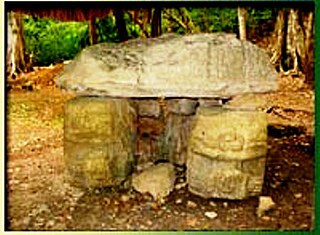
El Perú, is a pre-Columbian Maya archeological site occupied during the Preclassic and Classic cultural chronology periods. The site was the capital of a Maya city-state and is located near the banks of the San Pedro River in the Department of Petén of northern Guatemala. El Perú is 60 km (37 mi) west of Tikal.
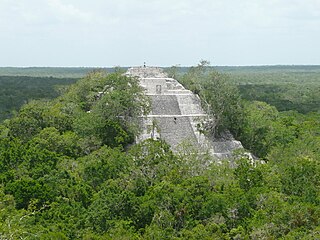
Calakmul is a Maya archaeological site in the Mexican state of Campeche, deep in the jungles of the greater Petén Basin region. It is 35 kilometres (22 mi) from the Guatemalan border. Calakmul was one of the largest and most powerful ancient cities ever uncovered in the Maya lowlands.

K'inich Yax K'uk' Mo' is named in Maya inscriptions as the founder and first ruler, k'ul ajaw, of the pre-Columbian Maya civilization polity centered at Copán, a major Maya site located in the southeastern Maya lowlands region in present-day Honduras. The motifs associated with his depiction on Copán monuments have a distinct resemblance to imagery associated with the height of the Classic-era center of Teotihuacan in the distant northern central Mexican region, and have been interpreted as intending to suggest his origins and association with that prestigious civilization. One of the most commonly cited motifs for this interpretation is the "goggle-eyed" headdress with which Yax K'uk' Mo' is commonly depicted; this is seemingly an allusion to the northern central Mexican rain deity known as Tlaloc by later peoples, such as the Aztecs. However, modern strontium isotope analysis of the human remains recovered from the tomb attributed to him indicate that K'inich Yax K'uk' Mo' spent his formative years much closer to Copán, at Tikal, and had not himself lived at Teotihuacan.
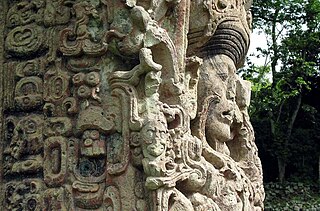
Uaxaclajuun Ub'aah K'awiil, was the 13th ajaw or ruler of the powerful Maya polity associated with the site of Copán in modern Honduras. He ruled from January 2, 695, to May 3, 738.

Altar Q is the designation given to one of the most notable of the rectangular sculpted stone blocks recovered at the Mesoamerican archaeological site of Copán, present-day Honduras.

Río Azul is an archaeological site of the Pre-Columbian Maya civilization. It is the most important site in the Río Azul National Park in the Petén Department of northern Guatemala, close to the borders of Mexico and Belize. Río Azul is situated to the southeast of the Azul river and its apogee dates to the Early Classic period.

Chak Tok Ich'aak I also known as Great Paw, Great Jaguar Paw, and Toh Chak Ich'ak was an ajaw of the Maya city of Tikal. He took the throne on August 7, 360? and reigned until his death in 378, apparently at the hands of invaders from central Mexico.

The known rulers of Tikal, a major centre of the Pre-Columbian Maya civilization in modern-day Guatemala:

Maya stelae are monuments that were fashioned by the Maya civilization of ancient Mesoamerica. They consist of tall, sculpted stone shafts and are often associated with low circular stones referred to as altars, although their actual function is uncertain. Many stelae were sculpted in low relief, although plain monuments are found throughout the Maya region. The sculpting of these monuments spread throughout the Maya area during the Classic Period, and these pairings of sculpted stelae and circular altars are considered a hallmark of Classic Maya civilization. The earliest dated stela to have been found in situ in the Maya lowlands was recovered from the great city of Tikal in Guatemala. During the Classic Period almost every Maya kingdom in the southern lowlands raised stelae in its ceremonial centre.

Tikal Temple 33 was a 33-metre-high (108 ft) ancient Maya funerary pyramid located in the North Acropolis of the great Maya city of Tikal. The pyramid was centrally situated in the front row of structures facing onto the Great Plaza, between Temples 32 and 34 and in front of the Northern Platform. Temple 33 is one of the most thoroughly explored temples in the entire Maya area. The earliest version was a low funerary shrine over the tomb of king Siyaj Chan K'awiil II, which was sealed in AD 457. Temple 33 underwent three consecutive phases of construction, during which the king's funerary shrine was remodelled and one of his stelae was interred above his tomb. In the mid-1960s, archaeologists completely dismantled the final version of the large pyramid, uncovering the earlier phases of construction.

The North Acropolis of the ancient Maya city of Tikal in Guatemala is an architectural complex that served as a royal necropolis and was a centre for funerary activity for over 1300 years. The acropolis is located near the centre of the city and is one of the most studied of Maya architectural complexes. Excavations were carried out from 1957 to 1969 by the University of Pennsylvania, directed by Edwin M. Shook and William Coe.

The history of Maya civilization is divided into three principal periods: the Preclassic, Classic and Postclassic periods; these were preceded by the Archaic Period, which saw the first settled villages and early developments in agriculture. Modern scholars regard these periods as arbitrary divisions of chronology of the Maya civilization, rather than indicative of cultural evolution or decadence. Definitions of the start and end dates of period spans can vary by as much as a century, depending on the author. The Preclassic lasted from approximately 2000 BC to approximately 250 AD; this was followed by the Classic, from 250 AD to roughly 950 AD, then by the Postclassic, from 950 AD to the middle of the 16th century. Each period is further subdivided:
